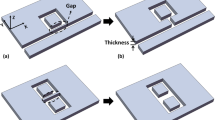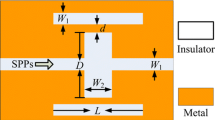Abstract
Metal-insulator-metal (MIM) waveguide has deep sub-wavelength field confinements, which makes it an important component in many aspects. In MIM structure, both of the symmetric and anti-symmetric modes could be supported. However, the anti-symmetric mode was hardly used in the SPP-based devices due to the critical excitation condition. Here, we demonstrate anti-symmetric mode excitation and Fano resonance in a compact MIM-based plasmonic structure. By changing the position of the output channel, the symmetric mode is suppressed and only anti-symmetric mode is excited. Then, we tune the position of the output channel; anti-symmetric and symmetric mode are both achieved. Furthermore, Fano resonance is realized due to the coupling between anti-symmetric mode and symmetric mode. In addition, we analyze the effects of the parameters of the structure on the transmission spectra, and a plasmonic refractive index sensor with sensitivity about 800 nm/RIU and 1100 nm/RIU based on different waveguide modes is also realized. The proposed structure provides a novel method to achieve anti-symmetric mode excitation, and it has important applications in nanophotonic devices such as filter, sensor, and photoswitch, and has important significance in achieving all-optical on-chip integration.




Similar content being viewed by others
References
Chen Z, Yu L, Wang L, Duan G, Zhao Y, Xiao J (2015) A refractive index nanosensor based on Fano resonance in the plasmonic waveguide system. IEEE Photon Technol Lett 27:1695–1698
Yang J, Song X, Chen Z, Cui L, Yang S, Yu L (2017) Tunable multi-Fano resonances in MDM-based side-coupled resonator system and its application in nanosensor. Plasmonics 12:1665–1672
Jankovic N, Cselyuszka N (2018) Multiple Fano-like MIM plasmonic structure based on triangular resonator for refractive index sensing. Sensors 18:287
He ZH, Zhao JL, Lu H (2019) Tunable nonreciprocal reflection and its stability in non-PT-symmetric plasmonic resonators coupled waveguide systems. Appl Phys Express 13:012009
Guo ZH, Zhang GM, Qiao LT, Ren PP, Zhao YP (2020) Design of the voltage tunable side-coupled asymmetric Y-type resonance cavity MIM filter based on surface plasmon polaritons. OSA Continuum 3:609–619
Zhu X, Shi H, Zhang S, Liu Q, Duan H (2017) Constructive-interference-enhanced Fano resonance of silver plasmonic heptamers with,a substrate mirror: a numerical study. Opt Express 25:9938–9946
Chen J, Sun C, Li H, Gong Q (2014) Experimental demonstration of an on-chip polarization splitter in a submicron asymmetric dielectric-coated metal slit. Appl Phys Lett 104:231111
Kelaita YA, Fischer KA, Babinec TM, Laoudakis KG, Sarmiento T, Rundquist A, Majumdar A, Vuckovic J (2017) Hybrid metal-dielectric nanocavity for enhanced light-matter interactions. Opt Mater Express 7:231–239
Chen Z, Chen S, Wang Y, Xiao L (2019) Tunable atom-trapping based on a plasmonic chiral metamaterial. Nanophotonics 8:1739–1745
Qin M, Wang L, Zhai X, Xia S (2019) Multispectral resonances and coherent control in plasmonic metasurfaces. IEEE Photon Technol Lett 31:319–322
Chen Z, Song X, Duan G, Wang L, Yu L (2015) Multiple Fano resonances control in MIM side-coupled cavities systems. IEEE Photon J 7:2701009
Wang G, Lu H, Liu X, Mao D, Duan L (2011) Tunable multi-channel wavelength demultiplexer based on MIM plasmonic nanodisk resonators at telecommunication regime. Opt Express 19:3513–3518
Chen JJ, Li Z, Zhang R, Deng ZL, Xiao JH, Gong QH (2013) Response line-shapes in compact coupled plasmonic resonator systems. Plasmonics 8:1129–1134
Chen Z, Chen M, Li J, Wang L, Jiao R, Duan G, Yu L, Xiao J (2016) Symmetry breaking induced mode splitting based on a plasmonic waveguide system. J Phys D Appl Phys 49:145109
Wen K, Yan L, Pan W, Luo B, Guo Z, Guo Y, Luo X (2014) Electromagnetically induced transparency-like transmission in a compact side-coupled T-shaped resonator. J Lightwave Technol 32:1701–1707
Lu H, Liu X, Wang L, Gong Y, Mao D (2011) Ultrafast all-optical switching in nanoplasmonic waveguide with Kerr nonlinear resonator. Opt Express 19:2910–2918
Chen Z, Cao X, Song X, Wang L, Yu L (2016) Side-coupled cavityinduced Fano resonance and its application in nanosensor. Plasmonics 11:307–313
Chen JJ, Li Z, Li J, Gong QH (2011) Compact and high-resolution plasmonic wavelength demultiplexers based on Fano interference. Opt Express 19:9976–9985
Chen Z, Yu L (2014) Multiple Fano resonances based on different waveguide modes in a symmetry breaking plasmonic system. IEEE Photon J 6:4802208
Lu H, Liu MX, Mao D, Wang GX (2012) Plasmonic nanosensor based on Fano resonance in waveguide-coupled resonators. Opt Lett 37:3780–3782
Chen Z, Chen JJ, Yu L, Xiao JH (2015) Sharp trapped resonances by exciting the anti-symmetric waveguide mode in a metal insulator metal resonator. Plasmonics 10:131–137
Wang S, Zhao T, Yu S, Ma W (2020) High-performance nano-sensing and sslow-light applications based on tunable multiple Fano resonances and EIT-like effects in coupled plasmonic resonator system. IEEE Access 8:40599–40611
Chen Y, Chen L, Wen K, Hu Y, Lin W (2020) Independently tunable Fano resonances in a metal-insulator-metal coupled cavities system. Appl Opt 59:1484–1490
Zhang BH, Wang LL, Li HJ, Zhai X, Xia SX (2016) Two kinds of double Fano resonances induced by an asymmetric MIM waveguide structure. J Opt 18:065001
Johnson PB, Christy RW (1972) Optical constants of the noble metals. Phys Rev B 6:4370–4379
Chen Z, Yu L, Wang L, Duan GY, Zhao YF, Xiao JH (2015) Sharp asymmetric line shapes in a plasmonic waveguide system and its application in nanosensor. J Lightwave Technol 33:3250–3253
Liu N, Mesch M, Weiss T, Hentschel M, Giessen H (2010) Infrared perfect absorber and its application as plasmonic sensor. Nano Lett 10:2342–2348
Liu N, Weiss T, Mesch M, Langguth L, Eigenthaler U, Hirscher M, Sonnicsen C, Giessen H (2010) Planar metamaterial analogue of electromagnetically induced transparency for plasmonic sensing. Nano Lett 10:1103–1107
Luk’yanchuk B, Zheludev NI, Maier SA, Halas NJ, Nordlander P, Giessen H, Chong CT (2010) The Fano resonance in plasmonic nanostructures and metamaterials. Nat Mater 9:707–715
Miroshnichenko AE, Flach S, Kivshar YS (2010) Fano resonances in nanoscale structures. Rev Mod Phys 82:2257–2298
Xu Q, Sandhu S, Povinelli ML, Shakya J, Fan SH, Lipson M (2006) Experimental realization of an on-chip all-optical analogue to electromagnetically induced transparency. Phys Rev Lett 96:123901
Lu H, Liu X, Wang G, Mao D (2012) Tunable high-channel-count bandpass plasmonic filters based on an analogue of electromagnetically induced transparency. Nanotech 23:444003
Chen J, Sun C, Gong Q (2014) Fano resonances in a single defect nanocavity coupled with a plasmonic waveguide. Opt Lett 39:52–55
Qi J, Chen Z, Chen J, Li Y, Qiang W, Xu J, Sun Q (2012) Independently tunable double Fano resonances in asymmetric MIM waveguide structure. Opt Express 22:14688–14695
Paul S, Ray M (2017) Simultaneous switching at multiple wavelengths using plasmon induced transparency and Fano resonance. IEEE Photon Technol Lett 29:739–742
Lu Q, Wang Z, Huang Q, Jiang W, Wu Z, Wang Y, Xia J (2017) Plasmon-induced transparency and high-performance slow light in a plasmonic single-mode and two-mode resonators coupled system. J Lightwave Technol 35:1710–1717
Ye Y, Xie Y, Song T, Liu B, Chai J, Zhang L, Zhu Y, Liu Y (2019) Tunable plasmon-induced transparency in dual hexagonal resonators with rotatable embedded bar. IEEE Photon J 11:4801813
Zhang T, Wang J, Liu Q, Zhou J, Dai J, Han X, Xu K (2019) Efficient spectrum prediction and inverse design for plasmonic waveguide systems based on artificial neural networks. Photon Res 7:368–380
Chai Z, Hu X, Zhu Y, Sun S, Yang H, Gong Q (2014) Ultracompact chip-integrated electromagnetically induced transparency in a single plasmonic composite nanocavity. Adv Optical Mater 2:320–325
Chai Z, Hu X, Yang H, Gong Q (2016) Chip-integrated all-optical diode based on nonlinear plasmonic nanocavities covered with multicomponent nanocomposite. Nanophotonics 6:329–339
Funding
This work was supported by the National Natural Science Foundation of China (NSFC) (11704013) and National Science and Technology Innovation Special Zone Program of China.
Author information
Authors and Affiliations
Corresponding author
Additional information
Publisher’s Note
Springer Nature remains neutral with regard to jurisdictional claims in published maps and institutional affiliations.
Appendices
Appendix 1 Symmetric and anti-symmetric waveguide modes
As we know, both symmetric and anti-symmetric waveguide modes can be supported in MIM structure. According to ref. [21], symmetric and anti-symmetric waveguide modes have quite different field distributions. The symmetric waveguide mode has no node for the field distributions (Hz) in the air gap, while the anti-symmetric one has a node. To show these two different waveguide modes directly, we plot the Hz distributions at λ = 1152 nm and λ = 865 nm for the symmetric and anti-symmetric waveguide modes, which are shown in Fig. 5a and b, respectively. To display the phenomenon intuitively, the field distributions of Hz along the black dashed line are shown in Fig. 5c and d. Obviously, at λ = 1152 nm and λ = 865 nm, the symmetric and anti-symmetric modes are excited, respectively. For symmetric mode at λ = 1152 nm, the effective index is about neff ≈ 1.046535 + 0.0004306i, propagation distance of SPPs is about LSPPs ≈ 212.9 μm. For anti-symmetric mode at λ = 865 nm, the effective index is about neff ≈ 0.668646 + 0.001087i, and the propagation distance of SPPs is about LSPPs ≈ 63.3 μm. These results are consistent with the results shown in Fig. 1 in ref. [21].
Appendix 2 SPP power flows in the cavity for different waveguide modes
Different coupling methods make the phase of the SPPs coupled to the output channel change, which in turn causes the transmission spectrum to change. Different transmission peaks/valleys correspond to different excitation modes of the resonator. Each excitation mode reflects the different transmission behavior of SPPs, which is important for understanding the relationship between the resonant wavelength of SPPs and the resonator parameters. Figure 6. show the field distributions of |Hz|2 and the SPP power flows (blue cone) at the resonant wavelength with L = H = 500 nm for different structures proposed in the manuscript. It is clear that the propagation behaviors of SPPs in the cavity are different in each other, even if the excited modes are the same, e.g., Fig. 6b, c, and e.
Rights and permissions
About this article
Cite this article
Chen, Z., Yu, Y., Wang, Y. et al. Compact Plasmonic Structure Induced Mode Excitation and Fano Resonance. Plasmonics 15, 2177–2183 (2020). https://doi.org/10.1007/s11468-020-01253-0
Received:
Accepted:
Published:
Issue Date:
DOI: https://doi.org/10.1007/s11468-020-01253-0






